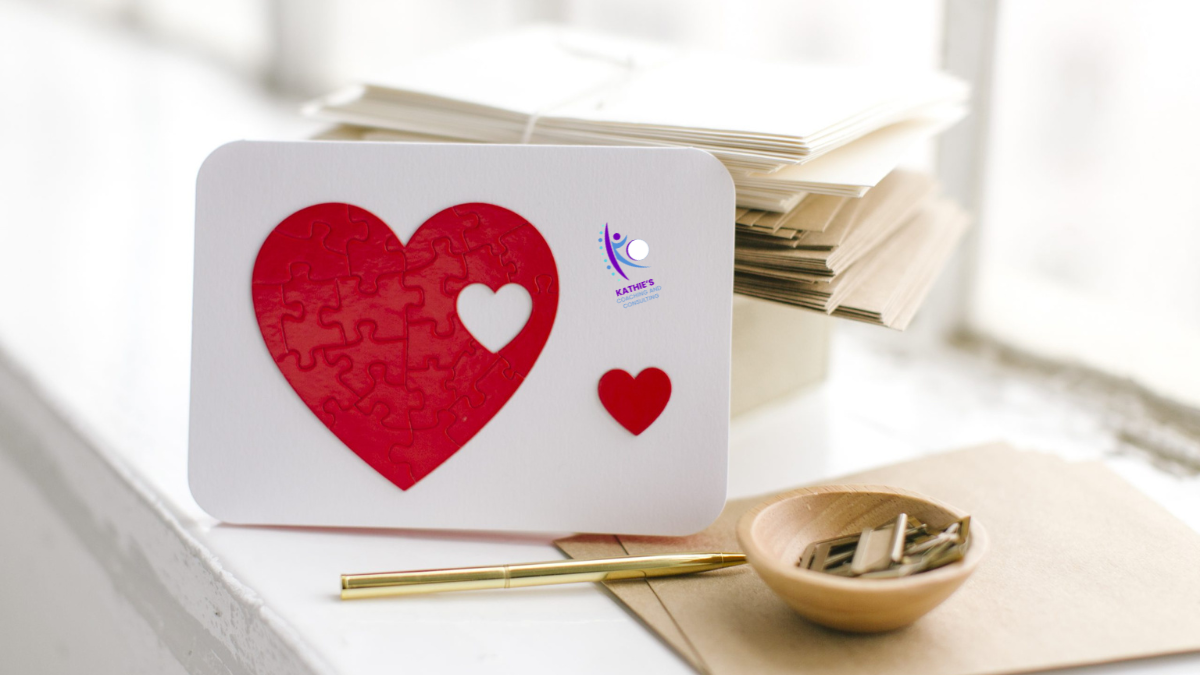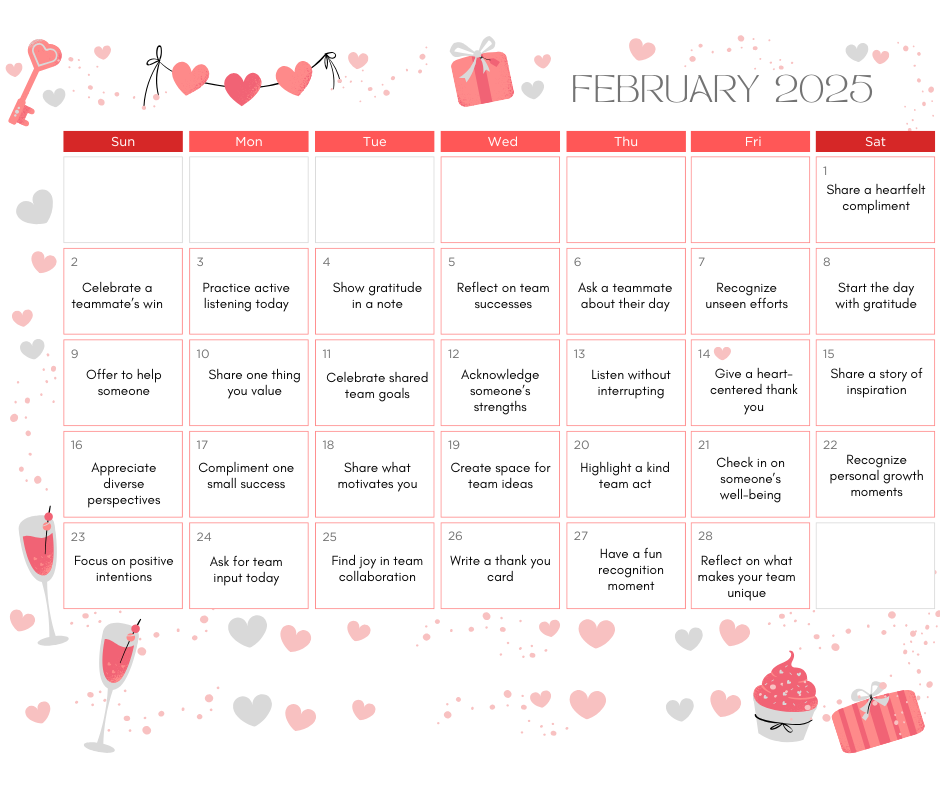The Hidden Power of Heart: Why Emotional Intelligence is Your Team's Secret Weapon
Emotional Awareness in the Workplace
Deadlines loom and KPIs dominate conversations, it’s easy to overlook one of the most critical components of a successful team: emotional awareness and recognition.
In fact, I have experienced this myself and it led to quiet quitting and even loss of top talent. -Kathie Owen
Yet, the power of connection—truly seeing, hearing, and appreciating the people we work with—is unmatched in its ability to create engaged, productive, and resilient teams.
Let’s dive into the heart of employee engagement strategies (pun intended), exploring how emotional awareness and recognition can transform your workplace into a thriving ecosystem of collaboration and support.
This is the heart of our February 2025 calendar. Download it now and share with your team, no matter what month you are in. We could all use some emotional awareness and recognition in our lives!
What is emotional awareness
What is Emotional Awareness?
Emotional awareness is the ability to recognize, understand, and manage your own emotions while also being attuned to the emotions of others. Learn more about emotioanl awareness in the workplace.
In a team setting, this means being mindful of how individuals feel about their roles, responsibilities, and relationships with colleagues.
It’s the first step toward fostering a culture where employees feel valued, heard, and motivated to contribute their best.
Being emotionally aware isn’t about walking on eggshells or avoiding tough conversations.
Instead, it’s about approaching interactions with empathy and understanding, allowing everyone to bring their whole selves to work without fear of judgment.
Why Recognition Matters
Recognition is the heartbeat of emotional awareness. When team members feel seen and appreciated for their contributions, their engagement skyrockets.
Recognition satisfies a deep human need for validation, fostering a sense of purpose and belonging.
According to research by Gallup, employees who receive regular recognition are four times more likely to be engaged and five times more likely to stay with their organization than those who do not.
Recognition doesn’t just make people feel good; it’s a strategic tool for improving retention, morale, and productivity.
Heart-Centered Team Engagement
The Power of Heart-Centered Engagement
Engagement strategies that center around the heart prioritize authenticity, compassion, and genuine connections.
They go beyond transactional gestures and create meaningful moments that resonate deeply with employees.
Here are a few key principles:
Empathy Over Assumptions:
Empathy is the cornerstone of emotional awareness. Instead of assuming how someone feels, take the time to ask and listen. This creates a safe space for employees to express their thoughts and emotions.
Recognition Beyond Results:
Recognize not just outcomes but also efforts, creativity, and growth. Acknowledge the person, not just their performance.
Connection Before Correction:
Addressing challenges is necessary, but it’s more effective when done from a place of connection and understanding. Leading with empathy ensures that feedback feels supportive rather than punitive.
Celebrating Individuality:
Each team member brings unique strengths and perspectives. Heart-centered engagement celebrates diversity and helps everyone feel valued for who they are.
Building Emotionally Aware Teams
Strategies for Building Emotional Awareness in Teams
Foster Open Communication:
Create an environment where team members feel comfortable sharing their thoughts and feelings.
This could include regular one-on-one check-ins, anonymous feedback channels, or team forums where everyone’s voice is heard.
Practice Mindful Listening:
Active listening is a skill that can transform workplace relationships. When someone is speaking, focus fully on their words without interrupting or planning your response.
Show you’re engaged through eye contact, nodding, and verbal affirmations.
Encourage Self-Awareness:
Help team members reflect on their own emotions and triggers through tools like journaling, personality assessments, or emotional intelligence training.
The more self-aware individuals are, the better they can navigate workplace dynamics.
Model Emotional Awareness:
As a leader or team influencer, your actions set the tone for the group. Show vulnerability by sharing your own challenges and how you manage them.
This normalizes emotional awareness and encourages others to do the same.
Heart-Centered Recognition Tactics
Recognition doesn’t have to be grand or expensive to be meaningful. Here are some creative and heart-centered ways to show appreciation:
Personalized Thank-You Notes:
A handwritten note that acknowledges specific contributions shows thoughtfulness and effort. Mentioning a personal detail or a recent success makes it even more impactful.
Spotlight Success Stories:
Highlight team members in meetings, newsletters, or on internal platforms. Share their stories, emphasizing not just what they accomplished but also how they did it.
Peer-to-Peer Recognition:
Encourage team members to recognize one another. Implement systems like “Kudos Boards” or recognition apps where peers can share shoutouts and celebrate each other’s contributions.
Celebrate Milestones:
Don’t wait for massive achievements to celebrate. Small wins, work anniversaries, or even personal milestones like birthdays are great opportunities to show you care.
Customized Rewards:
Tailor rewards to individual preferences. For example, one employee might appreciate a public acknowledgment, while another might value extra time off or a gift card to their favorite coffee shop.
Real World Examples - Heart Centered Employee Engagement
Real-World Examples of Heart-Centered Engagement
To bring these strategies to life, here are a few inspiring examples:
The Gratitude Circle:
A tech company started every Friday meeting with a “Gratitude Circle,” where team members took turns sharing what they were thankful for about their colleagues.
This simple practice improved morale and strengthened relationships.
The Growth Jar:
A marketing agency introduced a “Growth Jar” where team members could anonymously write down and share something they learned or accomplished that week.
At the end of each month, the team read them aloud and celebrated the collective progress.
Recognition Rituals:
A healthcare organization created a ritual where managers gave out “Heart Awards” to employees who demonstrated kindness, resilience, or exceptional teamwork.
These awards became a symbol of pride and motivation.
Measuring the Impact of Emotional Awareness and Recognition
To ensure your efforts are making a difference, it’s essential to track progress. Here are a few metrics to consider:
Employee Engagement Scores: Use surveys to gauge how connected and motivated your team feels.
Retention Rates: Monitor turnover to see if increased recognition correlates with improved retention.
Team Feedback: Regularly ask employees how they feel about the workplace culture and what could be improved.
Productivity Metrics: Recognized employees often perform better. Track productivity levels to identify positive trends.
Learn more about assessments and surveys in the workplace here!
Emotional Awareness and Recognition in the Workplace
Bringing It All Together
Emotional awareness and recognition are not just feel-good concepts; they’re vital strategies for building high-performing teams.
When you lead with empathy, celebrate individuality, and center engagement around the heart, you create a workplace where everyone thrives.
As you implement these strategies, remember that small, consistent actions often have the most profound impact.
A kind word, a thoughtful gesture, or a moment of genuine connection can inspire loyalty, spark creativity, and strengthen bonds within your team.
So, start today. Tune into your team’s emotional landscape, recognize their efforts, and lead with heart.
The results will speak for themselves in the form of happier, more engaged, and more connected employees.
Emotional Intelligence - Employee Engagement
A Final Challenge
This week, try one heart-centered recognition tactic and observe the response.
Whether it’s a heartfelt thank-you, a peer shoutout, or a simple act of kindness, notice how it transforms the energy in your workplace. You might be surprised by how powerful a little recognition can be.
In the words of Maya Angelou:
“People will forget what you said, people will forget what you did, but people will never forget how you made them feel.”
Let’s make every workplace a place where people feel valued, appreciated, and inspired to give their best.
About the Author
Kathie Owen is a corporate wellness coach, consultant, and advocate on a mission to transform workplace cultures through holistic well-being strategies.
With over two decades of experience in fitness, wellness, and leadership coaching, Kathie specializes in helping teams thrive by fostering emotional awareness, preventing burnout, and boosting employee engagement.
She is the founder of Top Workplace Wellness, where she designs customized programs that inspire connection, productivity, and purpose. Through her workshops, blog, and coaching, Kathie empowers leaders and employees to create healthier, happier, and more engaged workplaces.





















Expectations shape how we see life—but what if we let them go? In this heartfelt post, I share how my dog Rusty, a courageous soul who lost his sight but never his spirit, taught me the three pillars of freedom: non-attachment, radical responsibility, and courage. When you expect nothing, you can handle anything. 💛
#Mindset #Courage #LettingGo #InnerExcellence #KathieOwen